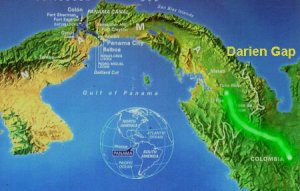When Harvey’s Flu ended in 2039, most countries felt lessons had been learned. If another disease arose and threatened to reach pandemic status, proven precautions were in place to lessen the spread and quickly contain the outbreak. They were ready for another flu. That isn’t what came.
 Ethno-botantist Adam Paul first documented the use of a fungus by rebels in the Darien Gap in 2040. The fungus was found in Central and South America, growing on soy plants genetically engineered to be resistant to pests. The fungus, when dried, pulverized, and ingested produced a foul taste in the mouth and sores, both of which were bad enough to make those afflicted abstain from eating until the symptoms passed in four to five days.
Ethno-botantist Adam Paul first documented the use of a fungus by rebels in the Darien Gap in 2040. The fungus was found in Central and South America, growing on soy plants genetically engineered to be resistant to pests. The fungus, when dried, pulverized, and ingested produced a foul taste in the mouth and sores, both of which were bad enough to make those afflicted abstain from eating until the symptoms passed in four to five days.
The rebels were using this natural toxin to incapacitate anyone interfering in the drug trade flowing through the rough trails they’d created in this once impassable region. Mr. Paul reported rumors of a few deaths from this strange fungus, but determined these were due to starvation or dehydration. He theorized this was a new type of fungus. His report garnered brief interest and was then forgotten until 2045.
Brazil averages 50,000 cases of leprosy every year. This figure has remain consistent for decades. The first documented case of HALO occurred in a leprosy center in northern Brazil. A woman died after complaining of a metallic taste in her mouth and cankers, followed by a swift worsening of her leprosy symptoms which led to her death as a result of multiple broken bones penetrating her lungs, liver, and finally her heart. The case was dismissed as an accidental death due to an unreported fall down the center’s stairs despite the nuns swearing no such incident had occurred. It was only after HALO was officially diagnosed that this unnamed woman originally from Columbia became known as the first verifiable case, though many theorize that there were others before based on a brief note in her file stating her children had died in a similar fashion after her husband returned from an overland journey to Panama, which has been interpreted to mean he had been escorting drugs through the Darien.
The center was then inundated with complaints of mouth cankers and sores in combination with a foul or metallic taste. The water and food was tested, but nothing was found to be causing the widespread outbreak. Visiting missionaries from a variety of countries were sent home as the symptoms were initially linked to tainted water, food, or even toxic mold growing within the center walls. It wasn’t until the first returned missionaries began dying, as well as the patients and nurses at the center, that it was discovered this was a disease and one that was highly contagious.
HALO stands for Halitosectic Autoimmune Leprotic Osteonecrosis. It is a disease like no other, a new class of illness that the world of 2045 was unprepared for. Admittedly, the United States was still reeling from the devastation of Hurricane Lempert in 2042, distract with analyzing possible scenarios to save Miami and areas of Florida while dealing with the enormous cost of the losses. The world had recovered from Harvey’s Flu. Another potential pandemic did not seem possible.
Much of the information on the beginnings of HALO came after the outbreak once it was recognized to be a disease and not a poison or weird accidental death or multiple diseases affecting a single individual as was initially theorized. Of course, in the aftermath of HALO the information left to sift through was vast and unorganized and there simply were not that many people to undertake the task, not when society had to be restored as well.
The organism discovered by Mr. Paul used by the rebels controlling the Darien Gap was not a fungus. Further study showed that it was a lichen, itself mutated to thrive on the genetically modified soy plants. This lichen specie is comprised of a fungus and a cyanobacteria, one that when ingested mixed with the Mycobacterium lepromatosis bacteria which causes leprosy, and became something new. It became a potent bacteria laced fungus that spread to its new host in deadly profusion. Few people had any resistance to this new class of disease and those infected early, before it was realized that a fungicide and an antibiotic were needed, had little hope of survival.
The initial complaints of a metallic taste and cankers were the initial sign of infection. The bad breath associated with this stage were the lichen diaspores dispersing to infect new hosts. The lichen, named Necrosos Mycocharrianin, entered the bloodstream of the infected individual causing two separate issues. The first was a sudden onset of leprosy-like symptoms. The second is the lichen itself colonizing the bone tissue, weakening it to the point the bones collapse and break, often puncturing organs. Death results from loss of blood and punctured organs rather from the lichen itself or from starvation or dehydration as a result of the initial symptoms of mouth cankers, which are usually severe. Diaspores were exhaled and shed in blood during the entire infection, including after death when any body not burnt would release thousands.
No cure has ever been found.




